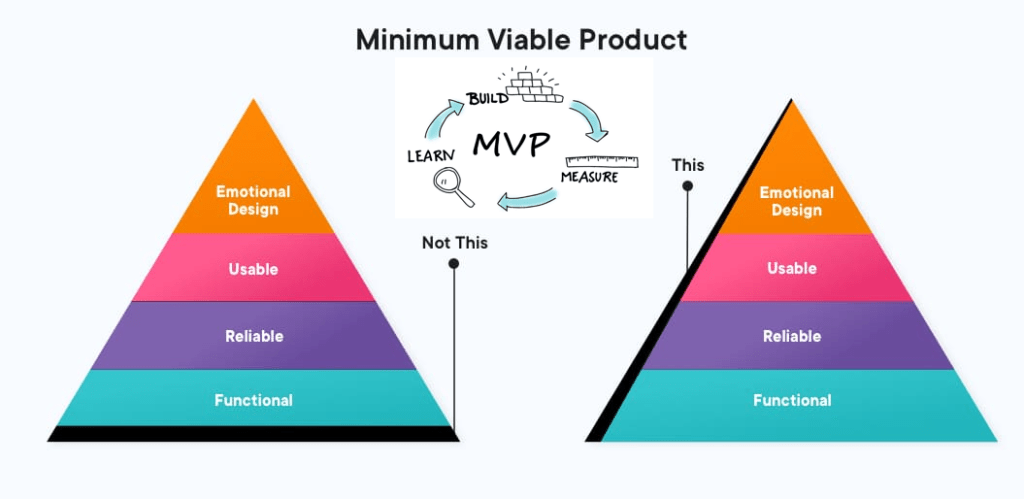
An Minimum Viable Product (MVP), is a version of a product that has the minimum set of features needed to satisfy early customers and validate a product idea. The goal of an MVP is to test the market and gather feedback from users in order to improve the product before investing significant resources into its development.
An MVP can take many forms, depending on the product and industry. For example, a MVP for a mobile app may be a basic version of the app with only a few core features, while a MVP for a physical product may be a prototype made with inexpensive materials.
When developing an MVP, it’s important to focus on the core features that are essential to the product’s value proposition. This means identifying and prioritizing the features that will help you achieve your goals, such as increasing user engagement or generating revenue.
Once an MVP is released, it’s important to gather feedback from early adopters and iterate on the product based on that feedback. This can involve adding new features, improving existing features, or removing features that aren’t working as well as expected.
Steps for creating Minimum Viable Product
There are several steps to creating a Minimum Viable Product (MVP):
- Identify the problem: Understand the problem that the MVP will solve and the target market it will serve.
- Define the MVP: Determine the minimum set of features that are required to solve the identified problem and serve the target market.
- Build the MVP: Use a lean development approach to build the MVP quickly and efficiently, focusing on the core features.
- Test the MVP: Release the MVP to a small group of early adopters to gather feedback on the product and its features.
- Analyze feedback: Analyze the feedback received from early adopters and use it to improve the MVP.
- Iterate: Continuously iterate on the MVP, adding new features and refining existing ones based on feedback and customer needs.
- Launch: Once the MVP has been refined and validated, it can be launched to the broader market.
- Monitor and measure: Keep monitoring the MVP progress and measure the impact of the MVP on the target market.
Examples of Minimum Viable Product
There are many examples of minimum viable products (MVPs) that have been developed and successfully launched by companies. Here are a few examples:
- Dropbox: The MVP of Dropbox was a video that demonstrated how the service worked. This allowed the founders to gauge interest in the product and secure funding before building the actual product.
- Airbnb: The MVP of Airbnb was a website that allowed users to book a spare room or a bed in someone’s home. The founders used this MVP to validate the concept and gain traction before expanding to include other types of rentals.
- Facebook: The MVP of Facebook was a website called “The Facebook” that was initially only available to students at Harvard. This MVP allowed the founders to test the concept and gain traction among a specific target market before expanding to other colleges and universities.
- Uber: The MVP of Uber was a black car service that was launched in San Francisco. This MVP allowed the founders to test the concept of on-demand transportation and gather feedback from customers before expanding to include other types of vehicles.
- Zappos: The MVP of Zappos was a website that sold shoes. The founders used this MVP to test the concept of online shoe sales and gather feedback from customers before expanding to include other types of products.
These examples demonstrate that MVPs can take many forms and can be used to validate a wide range of product concepts. By starting with a MVP, companies can reduce the risk and costs associated with full-scale product development while gathering valuable feedback from customers.
Benefits of Minimum Viable Product
The MVP approach helps to obtain customer feedback and validate a product idea before committing significant resources to it. Some benefits of MVP include:
- Reduced development costs: By focusing on the core features of a product, an MVP can be developed with a smaller budget and fewer resources.
- Faster time to market: An MVP can be developed and released to the market more quickly than a full-featured product.
- Early customer feedback: An MVP allows for early customer feedback, which can be used to improve the product and increase the chances of success.
- Reduced risk: By testing an MVP with real customers, a company can gauge the market’s interest in the product, and reduce the risk of failure.
- Learn and pivot: MVP allow entrepreneurs to test their hypotheses and pivot if necessary, providing a much better chance of success.
Conclusion
Overall, the MVP is a critical step in the product development process. It allows entrepreneurs and businesses to validate their product idea with minimal risk and investment and provides valuable insights for improving the product before committing significant resources.
